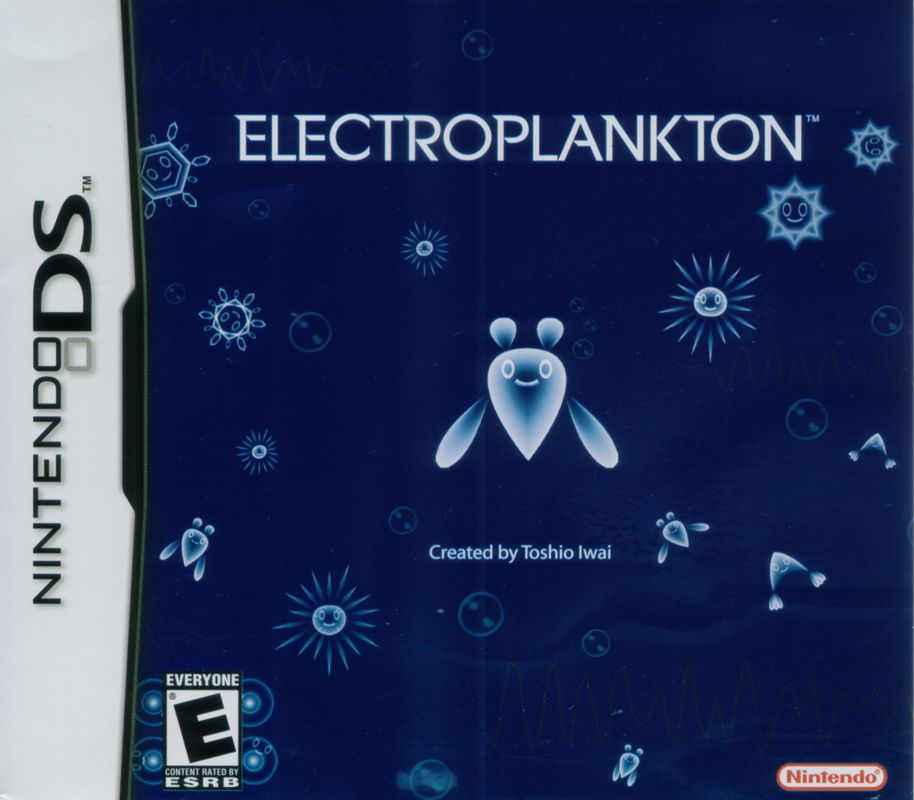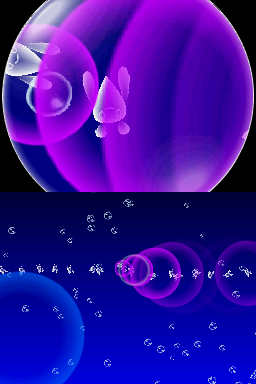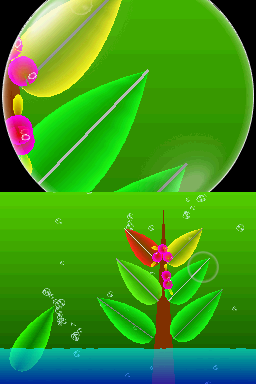Retro Replay Review
Gameplay
Electroplankton invites players to become live performers of audio-visual “media art” by interacting directly with a cast of whimsical plankton creatures. The Nintendo DS’s touch screen, microphone and physical buttons all serve as musical instruments and paintbrushes, giving you freedom to experiment with rhythm, melody and patterns. From drawing lines for Tracy’s swimmers to tilting the console for Nanocarp, every plankton responds in unique ways that reward playful curiosity.
The game offers two distinct modes: Audience and Performance. In Audience mode, you simply select a plankton type and sit back as it improvises an endless, battery-limited show. It’s a perfect introduction to the world of Electroplankton—wonderful ambient soundscapes that unfold without any input required. Performance mode, by contrast, hands you the reins entirely. You decide when to record, when to draw, when to clap into the mic—and thus compose one-of-a-kind audio-visual pieces on the fly.
With ten plankton to choose from—Tracy, Hanenbow, Luminaria, Sun-Animalcule, Rec-Rec, Nanocarp, Lumiloop, Marine-Snow, Beatnes, and Volvoice—there’s always a new combination of tools and surprises waiting. Want to sketch pathways and watch sounds materialize in Tracy? Or bounce Hanenbow against hand-drawn leaves for percussive tones? Each mini‐environment has its own set of rules and quirks, encouraging you to dive deeper and discover hidden interactions.
Learning each plankton’s mechanics is part of the fun. Some, like Rec-Rec and Volvoice, let you sample your own voice or external sounds, while others are purely visual-musical experiments. The gentle pace and open‐ended design mean there are no “wrong” moves—only new melodies and patterns born from your exploration.
Graphics
Electroplankton’s visuals are deceptively simple yet endlessly charming. Each plankton species is rendered in crisp, high‐contrast lines and bold colors that pop against the DS’s limited resolution. The minimalist aesthetic serves the game well, keeping your focus on the fluid motions and vibrant ripples that your inputs provoke.
The animations are delightfully responsive. When you draw a line for Tracy, watch the swimmers glide in real time, their shapes stretching and contracting with speed. Luminaria’s glowing orbs pulse as they cross grid intersections, while Lumiloop’s concentric circles spin faster and brighter the more you swipe. Even Nanocarp’s random darting seems purposeful when you see how it reacts to taps and claps.
Backgrounds remain unobtrusive, usually monochrome or textured very lightly, so the spotlight stays on the plankton. This restraint enhances the meditative mood: you’re not distracted by flashy UI elements or cluttered menus, but immersed in a living canvas that evolves with every touch.
Despite being a title for older hardware, Electroplankton manages to feel timeless thanks to its bold use of color and shape. There’s a handcrafted quality in each frame, as though you’re interacting with an evolving piece of digital art rather than a typical game screen.
Story
Unlike narrative‐driven titles, Electroplankton forgoes any traditional storyline or characters with arcs. Instead, its “story” emerges organically through your creative sessions. Each performance becomes a unique tale of sound and motion, driven by your choices and timing rather than scripted events.
This lack of a preset narrative is intentional: you are the author, conductor and spectator all at once. A single session might begin with gentle chimes from Marine-Snow, escalate into frenetic beeps from Beatnes, and wind down with whispered echoes recorded in Volvoice. The ebb and flow of your interactions craft a personal journey every time you play.
For players craving structure, the absence of plot may feel unfamiliar. But for those open to open‐ended, improvisational experiences, Electroplankton’s “story” is its greatest strength. It champions imagination over preset goals, letting you shape your own audio-visual odyssey.
Overall Experience
Electroplankton stands out as an art toy more than a conventional game. It offers boundless creative potential and a truly unique DS experience that taps into subconscious rhythms and childlike wonder. You won’t be chasing levels or unlocking achievements—instead, you’ll find yourself lost in the joy of exploration and self-expression.
The learning curve is exceptionally gentle. There’s no menu full of stats or hidden tutorials; you simply dive in and start touching, drawing, blowing into the mic or clapping your hands. That intuitive design makes it accessible to all ages, though it will especially delight musicians, sound designers and visual artists looking for a portable sandbox.
Replay value is measured more in hours of peaceful experimentation than in repeatable challenges. Battery life naturally limits session length, but it also turns each playthrough into a focused creative sprint. Whether you’re unwinding after work or collaborating in a group jam, Electroplankton always offers fresh surprises and meditative delight.
All told, Electroplankton is a rare invitation to see a handheld console not as a system of constraints but as a canvas of infinite possibility. If you’re searching for a game that doubles as a musical instrument and interactive art exhibit, look no further than this DS gem.
 Retro Replay Retro Replay gaming reviews, news, emulation, geek stuff and more!
Retro Replay Retro Replay gaming reviews, news, emulation, geek stuff and more!









Reviews
There are no reviews yet.